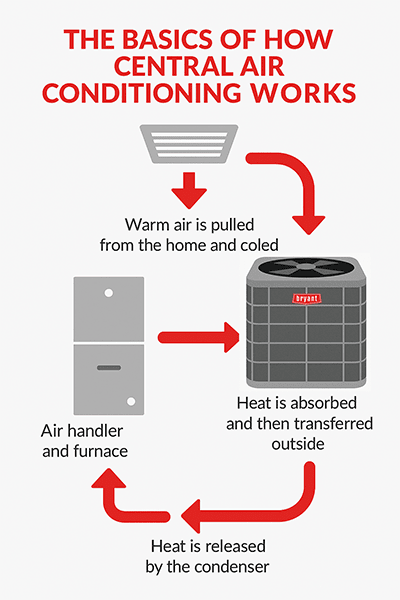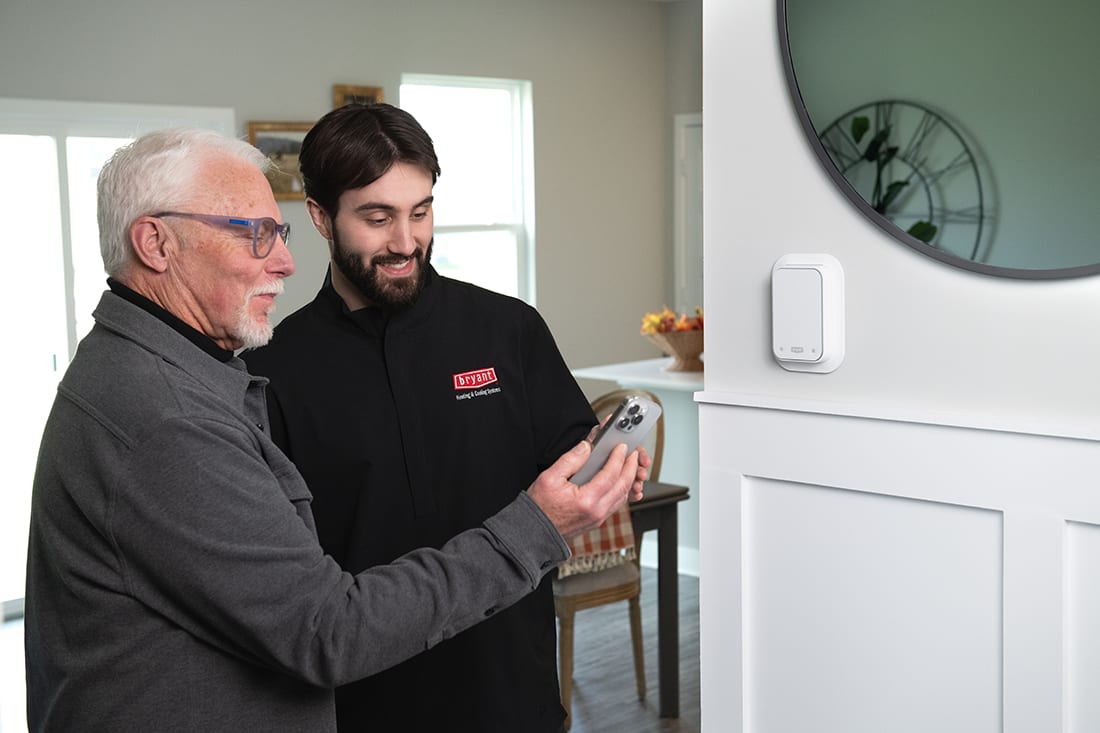About The Author: Travis Baugh is a Digital Brand Marketing Manager for Bryant, where he creates clear, helpful content to guide homeowners through heating, cooling, and indoor air quality decisions. His goal is to empower readers with the knowledge they need to choose the right comfort solutions for their home—confidently and comfortably.
How Does an Air Conditioner (AC) Work?
An air conditioner works by removing heat and humidity from an indoor space and transferring it outside. It uses a chemical refrigerant to absorb unwanted heat and a fan to circulate the cooled air, creating a comfortable indoor environment. This process is similar to how a refrigerator cools its interior.
Have you ever wondered about the technology that keeps your home cool and comfortable? The process is a fascinating cycle of heat transfer. In this guide, we will explore the basics of how an air conditioner works, detail the air conditioning cycle, and identify the key AC components that make it all possible. types of air conditioners
What is the Air Conditioner Process?

The air conditioner process is a continuous cycle of heat transfer. At its core, an air conditioning system is designed to remove heat and humidity from your living space, not just pump in cold air. The key to this process is a special fluid called a refrigerant.
Mike Lea, co-owner of Lea Heating & Air Conditioning in East Dundee, IL, breaks down how an air conditioner works.
“Air conditioners cool a space by removing heat and humidity from the indoor air and transferring that air outside,” Mike Lea, co-owner of Lea Heating & Air Conditioning in East Dundee, IL, said. “The simple definition is a heat transfer process by mechanical means."
Mark Lea, co-owner of Lea Heating & Air Conditioning, likens it to a refrigerator.
"You're not pumping cold air into the refrigerator," Lea said. "You're taking the space inside the refrigerator and removing the heat and the humidity to lower the temperature.”
Refrigerants absorb heat from the indoor air and carry it to the outdoor unit to be released. As the refrigerant circulates, it changes between a liquid and a gas, continuously absorbing and releasing heat. This air conditioning cycle is fundamental to maintaining your home's temperature and is a key factor in the efficiency of modern air conditioners.
Proper airflow is another vital part of the process. A balanced airflow ensures that cool air is distributed evenly throughout your home, preventing hot spots and maintaining a consistent temperature. This efficiency helps reduce energy consumption and can prolong how long your AC units last.
What is the Air Conditioning Cycle?
The air conditioning cycle, also known as the refrigeration cycle, is the process that allows your air conditioning system to cool your home. It consists of four main steps: evaporation, compression, condensation, and expansion. Understanding this cycle helps clarify how an air conditioner works to create a comfortable environment.
- Evaporation: In the evaporator coil (located indoors), the liquid refrigerant absorbs heat from your home's air and evaporates into a low-pressure gas. As the air passes over the cool coils, its temperature drops, providing relief from the heat.
- Compression: The gaseous AC refrigerant moves to the compressor, which is the heart of the system. The compressor pressurizes the gas, raising its temperature significantly.
- Condensation: This hot, high-pressure gas then travels to the condenser coil (located outdoors). Here, the refrigerant releases its heat into the outdoor air, with help from a fan. As it cools, it transforms back into a high-pressure liquid.
- Expansion: The liquid refrigerant passes through an expansion valve, which lowers its pressure and temperature. Now a cool, low-pressure liquid, it returns to the evaporator coil to restart the air conditioning cycle.
This continuous loop efficiently removes heat from your home. Bryant split AC units are designed with advanced technology to optimize this cycle, which can lead to lower energy use and reduced cooling bills.
What are the Main AC Components?
A central air conditioning system is made up of several key AC components that work together to cool your home. The main parts are the compressor, condenser, evaporator, and expansion valve.
- Compressor: Often called the heart of the system, the compressor pumps refrigerant through the closed loop. It pressurizes the refrigerant gas, preparing it to release heat outside.
- Condenser: Located in the outdoor unit, the condenser coil is where the hot refrigerant gas releases its heat into the surrounding air and condenses back into a liquid.
- Evaporator: The evaporator coil is situated inside your home. Here, the cool liquid refrigerant absorbs heat from the indoor air as it evaporates, cooling the air that is then circulated back into your living space.
- Expansion Valve: This component regulates the flow of refrigerant into the evaporator, reducing its pressure and temperature to ensure the system operates efficiently.
How Do You Maintain an Air Conditioner?
To keep your air conditioner running smoothly and prolong its life, regular AC maintenance is crucial. Simple tasks can make a big difference in performance and efficiency.
- Clean or replace your air filters every month during peak cooling seasons.
- Check the outdoor condenser coils for dirt and debris and clean them as needed.
- Ensure the AC drain line is clear to prevent water damage and clogs.
- Schedule professional maintenance at least once a year to identify potential issues early and maintain peak performance.
Connect With A Bryant Dealer to Learn More
If you still have questions about how an air conditioner works, your local Bryant dealer is ready to help. They can provide expert advice on system operation, efficiency ratings, and the best options for your AC installation and air conditioning service needs.

FAQs on How AC Works
An air conditioner circulates refrigerant through a closed loop, where it absorbs heat from indoor air at the evaporator coil, compresses the heated refrigerant, releases the heat outside via the condenser coil, and then cycles the cooled refrigerant back indoors. A blower fan pushes the cooled air through ducts or directly into the room.
An AC cools a room by removing heat and humidity from indoor air using refrigerant and then returning the cooled, dehumidified air back into the space through a fan system.
Most home air conditioners recirculate indoor air rather than pulling in air from outside; they cool the existing indoor air rather than introducing fresh outdoor air.
Learn More About Air Conditioners
- Find out what is an inverter air conditioner
- Explore and AC replacement
- Discover what size air conditioner you need
- Read our guides to AC parts
- Find out how long do AC units last?
- Discover the difference in a heat pump vs air conditioner
- Find out what temperature to set air conditioner in summer


